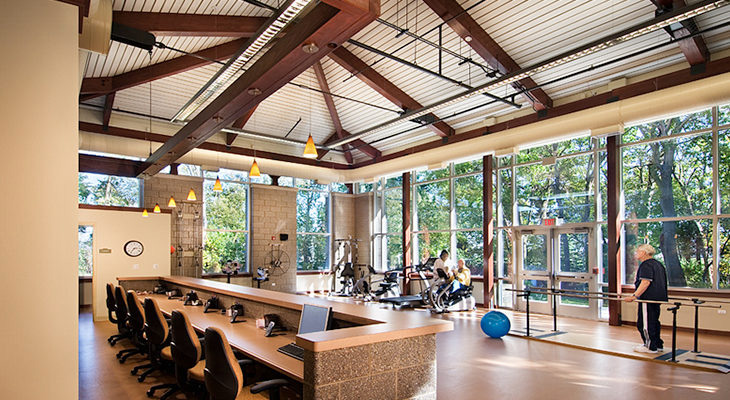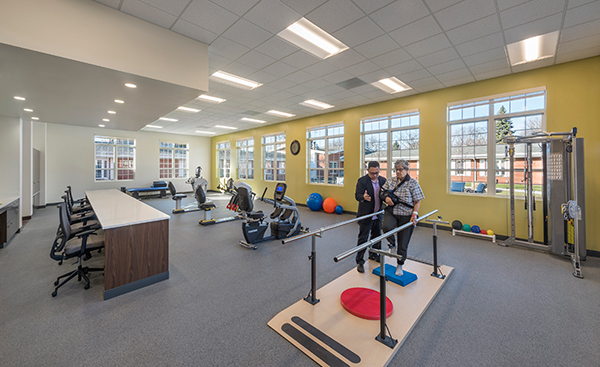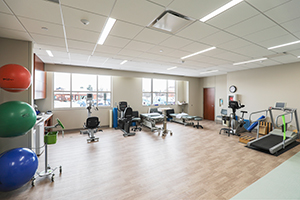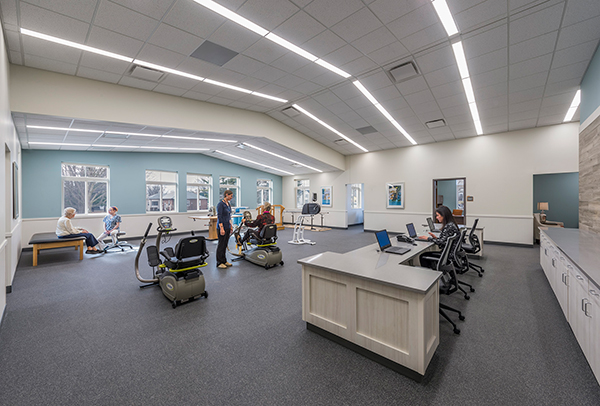
The architecture of confidence: modern physical therapy spaces designed with wellness in mind.
Physical therapy can create a whirlwind of emotions. Everyone approaches PT differently. Just as there are many different personalities, there are different approaches to therapy ranging from dutiful to reticent. Through it all, there are the therapists who must operate while coaxing the patients along. Recovery is rarely linear.
Growth Market
According to the U.S. Bureau of Labor Statistics, the physical therapy industry is expected to grow 18% by 2029, with a total market value expected to be $45 billion by 2023. Physical therapy is increasingly seen as an essential part of wellness programs that support recovery, prevention, and long-term quality of life. This parallels the growth of the baby boomer population. With most patients over 65, physical therapy must work with everyone, but really needs to work for seniors and support their needs.
Pain, Fear, and Doubt
The greatest challenges to physical therapy are pain, fear, and doubt. When individuals start therapy, they experience all three. Patients come to therapy for a variety of reasons. Examples range from an immediate catastrophic injury to the lifelong degradation of conditions that need improvement for quality of life. One thing is true for all: if you do not establish proper methodologies for moving forward, you will lose all that you develop.
In the way of getting started are pain, fear, and doubt. Pain sets the limits to what you can do, yet patients are asked to push through slightly from time to time. Pain leads to fear, which becomes a limiting factor. Patients resist moving forward or move forward with improper techniques because they fear pain. It is not uncommon for patients to have a rational fear of never getting back to where they were before. Fear breeds doubt. Will it ever get better? What is taking so long? Will I be able to do all the things I did before? There does come a point in every therapeutic process where there is a plateau or even a regression. It can be demoralizing and stressful. That stress can be detrimental to progress. The physical therapist must work with the body and mind to help the process along to a successful outcome. When designing spaces, it is critical to be mindful of the mental aspects of physical therapy.

Supportive Environments
The key to combating pain, fear, and doubt is developing a supportive environment that yields positive results. Good spaces need to be designed to reduce the stressors that impede physical therapy. It is critical that there be daylight and views whenever possible. Connecting with nature and providing views to natural elements have been proven to reduce stress reactions. Many of the exercises can be repetitive in nature. Having the ability to focus on landmarks is important for balance, both mentally and physically. Those landmarks can be natural as well as man-made.
Artificial lighting is another important aspect of the interior environment. It is important for the main rehab spaces to have enough daylighting, but since these spaces are deep, large, and tall, adequate artificial lighting is critical. The correct color temperature and diffused lighting scheme that work with the exterior lighting and seamlessly supplement the daylight are key to a successful rehab space design. Diffuse lighting is critical. In therapy, many patients end up spending significant time on their backs doing exercises. The ceiling finish and effect should be considered. Similar to lighting is the aspect of color—the space needs to offer a mix of calm and energetic colors. Color can also be used for directional coding to assist in patient navigation.
Many of these rehab spaces, once occupied, tend to look quite cluttered. A variety of storage types creates easy access for therapists. Most of these storage accessories are parts of vendor-provided storage solutions. Special attention needs to be provided to carefully integrate this in the main design so that everything looks intentional and not like an afterthought.

Physical therapy spaces can be very loud. Therefore, acoustics play a key role in developing supportive environments. Instructions or even communication about progress must be clearly heard to avoid further injury or regression. Privacy also becomes a key component of physical therapy. For some, a physical therapy suite can be overwhelming. Having that personal connection with your therapists is important. They provide instruction and encouragement. High quality communication is essential for successful interventions. Beyond acoustics, privacy also means there need to be spaces for private consultation or individual exercise areas away from prying eyes. When patients are comfortable, they will be more likely to focus on their efforts. As we see in schools and businesses, physical therapy is available to all neurodiversities. So having spaces that allow patients to find their own equilibrium is necessary. If patients are engaged in their process, there will be better outcomes. The space needs to support comfort.
While daylight plays a significant role, there also needs to be wall space needs to accommodate equipment, exercises, and mirrors. There needs to be a balance between walls and windows to maximize the functionality of the physical therapy space. You need to be able to see your own form to make sure you are exercising the right way. Mirrors in key locations are helpful. Using the wall to brace certain movements is critical for alleviating stress on the body. And there are always different types of equipment necessary to work on different muscle groups. Preparation of the space to support all types of exercise is also important. Having flexible arrangements to move equipment around as well as in and out of the space is necessary. That means there needs to be convenient device locations to allow for this flexibility.
It is vital to never lose sight of the therapists, who also experience stress with patients and their recovery. Spaces must allow therapists to catch their breaths, too. Training is important to address. There are always new techniques and strategies that they need to be aware of. Consultation is another critical factor to address. When there is alignment between the orthopedists, physical therapists, and the patient, there are more opportunities for alignment of care.

Resist Monotony
A person can be in physical therapy for months. Most insurances will cover 20 to 30 sessions. At the beginning, a patient could potentially have three visits a week to establish healthy patterns. Seeing the same space over and over can lead to monotony. Developing spaces with nature in mind allows for unique environments that can help break the monotony. Having the ability to change your environment by going outside to work on supportive tasks, weather permitting, can be refreshing. Physical therapists want to work on everyday movement skills as part of a healthy intervention. Giving them spaces and places that allow them to work on skills in different manners allows them to use their creativity. Creativity is the best way to overcome monotony by creating opportunities.
Celebrate the Victories!
Achievements, big or small, are all important. Recovery is not linear. When you overcome a barrier or achieve a milestone, it should be celebrated. People want to have fun and will frequent fun spaces. It goes back to engagement—an engaged patient is more likely to stick to the plan. Only 50% of physical therapy patients stick it out until the end. Frustration can settle in as can doubt. Having patients look forward to their sessions is a way to overcome frustration and doubt.
Contact us to learn more about physical therapy design or comment below to share your thoughts on this post.


